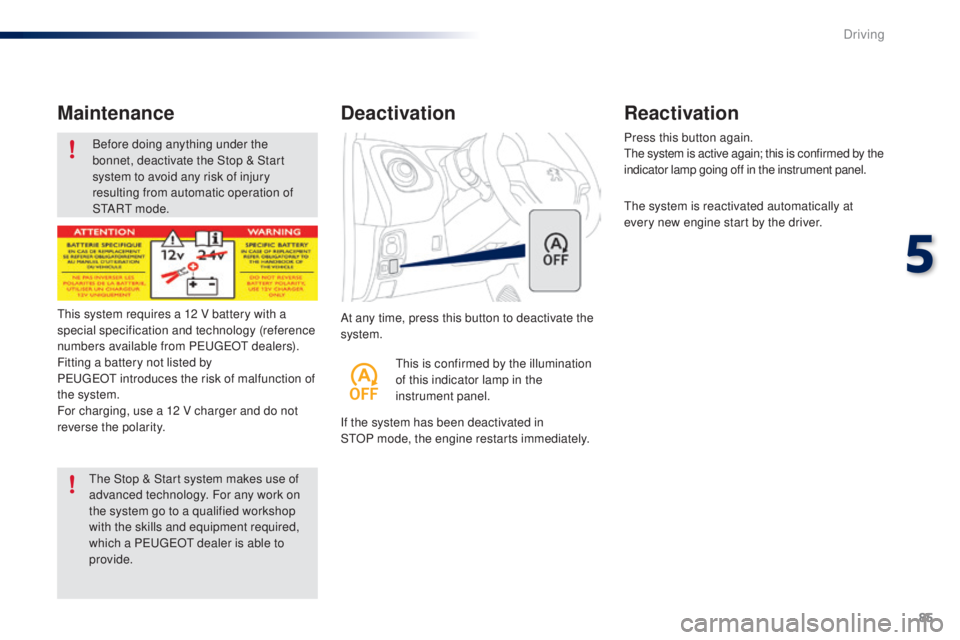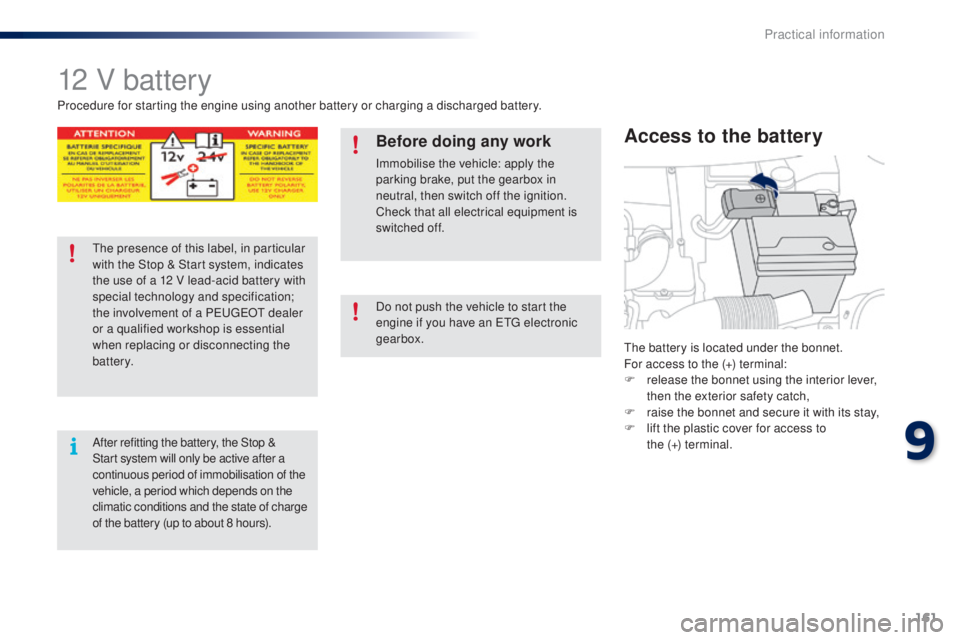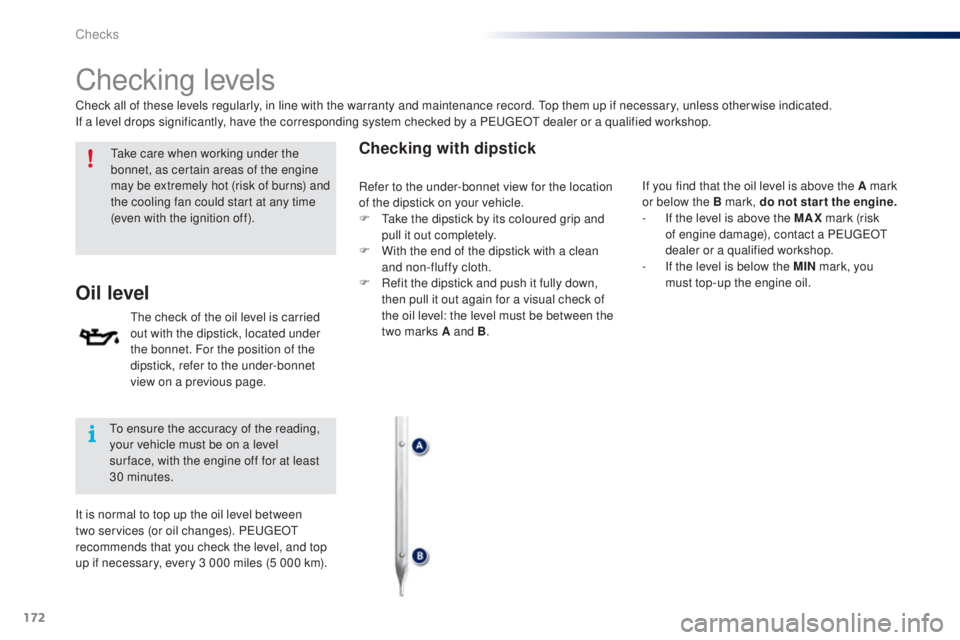Page 82 of 256
80
to engage reverse, the vehicle must be
stationary with your foot on the brake pedal.
F
Sel
ect position R .
Reverse
there is an audible signal on engaging reverse.
th
e vehicle can be stopped whatever the
position of the gear lever ( N, E or R ).
However, there is an audible signal on opening
the driver's door if the gear lever is not in
position N .
Stopping the vehicle
In all cases, it is essential that you
apply the parking brake to immobilise
the vehicle.
When the vehicle is stopped with the
engine running, always put the gear
lever into neutral N .
Before doing anything under the
bonnet, check that the gear lever is
in neutral N and the parking brake is
applied. With the ignition on, illumination
of this warning lamp indicates a
gearbox fault.
Contact a P
e
uge
Ot
dealer or a
qualified workshop.
Operating fault
Driving
Page 86 of 256
84
Going into engine START mode
this indicator lamp goes off and the
engine starts automatically:
-
w
hen you fully depress the clutch pedal. StA
Rt mode is invoked automatically when:
- y ou open the driver's door,
-
y
ou open the bonnet,
-
y
ou unfasten the driver's seat belt,
-
s
ome special conditions (battery charge,
engine temperature, braking assistance,
descending a steep gradient, adjustment of
the air conditioning...) where the engine is
needed for control of a system.
Special cases: START invoked
automaticallyIn the event of a fault with the system,
this warning lamp flashes in the
instrument panel.
Operating fault
Have it checked by a Pe ugeOt dealer or a
qualified workshop.
Driving
Page 87 of 256

85
Before doing anything under the
bonnet, deactivate the Stop & Start
system to avoid any risk of injury
resulting from automatic operation of
S
t
A R
t m
o d e .
Maintenance
At any time, press this button to deactivate the
system.
Deactivation
If the system has been deactivated in
StOP mode, the engine restarts immediately. Press this button again.
th
e system is active again; this is confirmed by the
indicator lamp going off in the instrument panel.
th
e system is reactivated automatically at
every new engine start by the driver.
Reactivation
this is confirmed by the illumination
of this indicator lamp in the
instrument panel.
th
is system requires a 12 V battery with a
special specification and technology (reference
numbers available from P
e
uge
Ot d
ealers).
Fitting a battery not listed by
Pe
ugeOt
introduces the risk of malfunction of
the system.
For charging, use a 12 V charger and do not
reverse the polarity.
th
e Stop & Start system makes use of
advanced technology. For any work on
the system go to a qualified workshop
with the skills and equipment required,
which a P
e
uge
Ot
dealer is able to
provide.
5
Driving
Page 154 of 256
152
Changing a fuse
Access to toolsthe fuseboxes are located behind the
dashboard in the passenger compartment and
next to the battery under the bonnet.
th
e extraction tweezer is fixed at the front of
the underbonnet fusebox.
F
u
n
clip the plastic cover, located below
the windscreen, by pressing on the
two
catches.F
u
n
clip the fusebox cover by pressing on
the lug on the right.
F
R
emove the tweezer.
When unclipping the plastic cover, take
care not to remove the seal.
Practical information
Page 159 of 256
157
Fuse
N° Rating
(A) Functions
1 10Right hand dipped beam
2 10Left hand dipped beam - Headlamp adjustment
3 7. 5Right hand main beam
4 7. 5Left hand main beam
5* 15Fuel injection system
6* 7. 5Fuel injection system
7* 15Fuel injection system
8* 7. 5Cooling fan
9 7. 5Air conditioning
10* * 7. 5Fuel injection system - Brake lamps -
t
h
ird brake lamp
11 5Courtesy lamp - Boot lamp
12 10
Direction indicators - Hazard warning lamps - Instrument panel - Display screen
Fuses under the bonnet
F unclip the plastic cover, located below
the windscreen, by pressing on the
two
catches.
F
u
n
clip the fusebox cover by pressing on
the lug on the right, for access to the fuses.
When you have finished, carefully refit the
c ove r.
* V
ti 8
2 engine.
** V
ti 6
8 engine.
9
Practical information
Page 163 of 256

161
12 V battery
the battery is located under the bonnet.
For access to the (+) terminal:
F
r
elease the bonnet using the interior lever,
then the exterior safety catch,
F
r
aise the bonnet and secure it with its stay,
F
l
ift the plastic cover for access to
the (+)
terminal.
Access to the battery
Procedure for starting the engine using another battery or charging a discharged battery.
Before doing any work
Immobilise the vehicle: apply the
parking brake, put the gearbox in
neutral, then switch off the ignition.
Check that all electrical equipment is
switched off.
th
e presence of this label, in particular
with the Stop & Start system, indicates
the use of a 12 V lead-acid battery with
special technology and specification;
the involvement of a P
e
uge
Ot
dealer
or a qualified workshop is essential
when replacing or disconnecting the
battery.
After refitting the battery, the Stop &
Start system will only be active after a
continuous period of immobilisation of the
vehicle, a period which depends on the
climatic conditions and the state of charge
of the battery (up to about 8 hours). Do not push the vehicle to start the
engine if you have an
etg electronic
gearbox.
9
Practical information
Page 172 of 256
170
Bonnet
Do not open the bonnet when there is a
very strong wind.
When the engine is hot, handle the
exterior safety catch and the stay with
care (risk of burns).
F
P
ush the exterior safety catch to the left
and raise the bonnet. F u
n
clip the bonnet stay from its housing.
F
F
ix the stay in the notch to hold the bonnet
open.
Opening
F Pull towards you the interior release lever, located in the lower dashboard.
The cooling fan may star t after
switching off the engine: take care
with articles and clothing that might
be caught by the fan blades.
Closing
F take the stay out of the support notch.
F C lip the stay in its housing.
F
L
ower the bonnet and release it near the
end of its travel.
F
P
ull on the bonnet to check that it is fully
latched.
Protects the components of the engine and provides access for checking levels.
Because of the presence of electrical
equipment under the bonnet, it is
recommended that exposure to water
(rain, washing, ...) be limited.
Checks
Page 174 of 256

172
Checking levels
take care when working under the
bonnet, as certain areas of the engine
may be extremely hot (risk of burns) and
the cooling fan could start at any time
(even with the ignition off).
Oil level
the check of the oil level is carried
out with the dipstick, located under
the bonnet. For the position of the
dipstick, refer to the under-bonnet
view on a previous page.
Checking with dipstick
Check all of these levels regularly, in line with the warranty and maintenance record. top them up if necessary, unless other wise indicated.
If a level drops significantly, have the corresponding system checked by a Pe ugeOt dealer or a qualified workshop.
to e
nsure the accuracy of the reading,
your vehicle must be on a level
sur face, with the engine off for at least
30
minutes.
It is normal to top up the oil level between
two services (or oil changes). P
e
uge
Ot
recommends that you check the level, and top
up if necessary, every 3 000 miles (5 000 km). If you find that the oil level is above the A mark
or below the B mark, do not star t the engine.
-
I
f the level is above the MAX mark (risk
of engine damage), contact a P
e
uge
Ot
dealer or a qualified workshop.
-
I
f the level is below the MIN mark, you
must top-up the engine oil.
Refer to the under-bonnet view for the location
of the dipstick on your vehicle.
F
t
a
ke the dipstick by its coloured grip and
pull it out completely.
F
W
ith the end of the dipstick with a clean
and non-fluffy cloth.
F
R
efit the dipstick and push it fully down,
then pull it out again for a visual check of
the oil level: the level must be between the
two marks A and B .
Checks